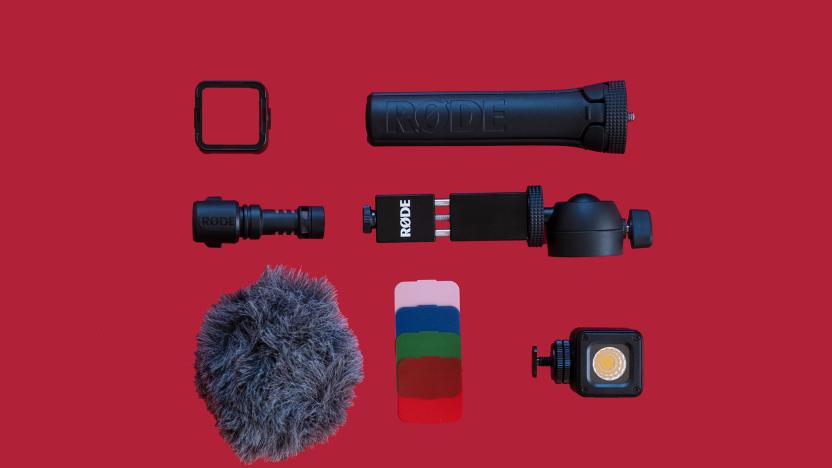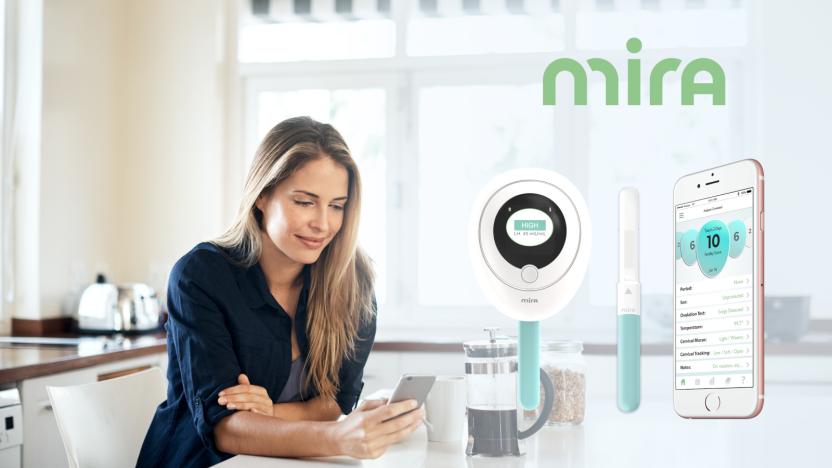kit
Latest

Rode’s Vlogger Kit might just find its way into my podcast toolbox
One of the best, quickest and more affordable ways to upgrade your phone videos is an external mic. Rode takes things one step further with a whole kit aimed at improving your social clips.

A few Nintendo Labo kits drop to $20 each on Best Buy
Best Buy is offering discounts on select on Nintendo Labo kits, including a VR starter kit.

Facebook releases an experimental messaging app for Apple Watch
Facebook's latest experimental app is designed to help you keep in touch with family and close friends.

Arcade Coder teaches kids to build games for the whole family
Tech Will Save Us (TWSU), the company behind cool kids' STEM kits, has launched a new flagship product designed to get kids into game design. The Arcade Coder is a 12-inch by 12-inch board with 144 fully programmable and controllable multi-colored LED buttons, that teaches children aged six and over easy-to-learn block coding and how to design their own games.

Mira's AI-powered fertility monitor is now available for purchase (update)
A company called Mira showed off its fertility monitor at CES earlier this year with the promise that it's much more accurate than the other digital trackers out there. Now, the technology is finally available for purchase worldwide. Mira's Fertility Starter kit comes with an AI-powered egg-shaped analyzer and 10 disposable test wands. Unlike the trackers that only tell you if you're ovulating or not, Mira tells you the quantity of Luteinizing hormone (LH) in your urine, which means you can use it to determine your peak fertility days. You only have to pee on a wand and stick it into the monitor to get your results.

Patreon promises a simple solution for selling merch
If you've ever supported a Patreon campaign with merch on offer, you know how painful delivering that merch can be for everyone involved. The creator may have to suffer through hours of mailing goods, and the shipping costs can be as much of a hassle if you aren't willing to pay a stiff premium. Patreon might just tackle that problem. It just acquired the community-building company Kit, and the two are promising a "simple" solution that lets creators sell merch without doing most of the hard work. In theory, they don't have to do much more than design the products.

Scientists are developing an invisibility cloak for solar panels
Current solar panel technology has enough trouble as it is converting sunlight into useable current, what with their paltry 20 percent average efficiencies. And it certainly doesn't help matters that up to a tenth of every solar panel's active collection areas are obscured from the sun by electrical leads called "contact fingers." But researchers at the Karlsruhe Institute of Technology (KIT) have developed a novel workaround: they're wrapping the finger contacts in little invisibility cloaks.

Butterfly wings are the key to glare-free phone displays
Butterflies have proven to be a surprising source of inspiration for technology, and that trend isn't about to slow down any time soon. German researchers have discovered that irregular, nanoscopic structures on the glasswing butterfly's namesake transparent wings eliminate most reflections at any angle -- perfect for phones, camera lenses and most any other device where display glare is a problem. The scientists have yet to completely recreate this surface in the lab, but they foresee a future where you're not struggling to read your smartphone outdoors. And the kicker? Prototypes are already self-cleaning and water-repellant, so you wouldn't need extra coatings to keep your screens largely smudge-free. [Image credit: Radwanul Hasan Siddique, KIT]

WoW Archivist: Epics
WoW Archivist is a biweekly column by WoW Insider's Scott Andrews, who explores the secrets of World of Warcraft's past. What did the game look like years ago? Who is etched into WoW's history? What secrets does the game still hold? It first appeared on our sister site on November 21st and is included here by permission. Leveling through Draenor has been a blast, but as I am a player from classic WoW, a few things have struck me as incredibly strange. Triple-digit numbers in the guild panel. Sending NPCs to do quests on my behalf. And most of all, getting epic armor and weapons from solo leveling quests. Many players in classic WoW (and not just raiders) opposed making epics more available to players. They called Blizzard's evolving attitude a slippery slope. "What's next," they argued, "epics for doing solo quests?" They never actually imagined that would happen. In 2005 it would have been unthinkable. Eight years later, here we are. But it's all been by design -- an evolving design with many steps along the way. Let's look at how we got here, one random drop at a time.

Lomography's DIY 35mm camera, now with flash
Last summer, Lomography debuted its offering that allows photogs to build their own 35mm SLR. Now, the retro-minded snapshooting outfit is lending a new model of its Konstruktor more film-shooting skills with flash kits. Thanks to a $20 accessory package, the latest version of the DIY camera can be paired with a Lomography flash should the need arise -- if you've already splurged for it and the proper lighting add-on. Those who've yet to take the leap can nab a bundle that includes the disassembled Konstruktor F, requisite accessory kit and a choice of flash for $103-$111 (depending on said selection). Not only can you put together the camera you'll use for to capture that next road trip, but you can ensure those images will be well lit, too.

Robotics kit steers kids away from complex code, toward fun projects
You''ve likely come into contact with one of the many wondrous robots with an Arduino brain, but actually building one yourself? That's hard enough for adults, let alone young kids. BirdBrain Technologies, the brains behind the Hummingbird Arduino Kickstarter project (along with Carnegie Mellon University) feels the same way and has just launched the Hummingbird Duo, a robotics Kickstarter project for kids "10 to 110." It's designed to ease the robotics learning curve with two boards: the original Hummingbird kit to help younger kids start making projects, and a "Leonardo" board for when they've gathered some experience. You'll get the same building blocks like LEDs, vibration motors, servers and sensors from the original kit, along with an integrated motor/servo shield and improved connectors on the second board.

LittleBits and Korg team up on Synth Kit modular DIY instrument, we go hands-on
Here's a pro tip: if you want to make this editor smile, hand me something that makes a bunch of noise. There are few things more satisfying than pressing some buttons and turning a few knobs to generate an avalanche of digital sound. And if what makes that noise is something you built yourself, all the better. LittleBits has been encouraging kids (and childish adults) to build their own electronic doodads and projects for some time now. And some of those creations even had the capability to make noise. But, the new Synth Kit released in collaboration with Korg is dedicated to DIY audio cacophony. Inside the gold and black packaging is a pile of snap-together components that will let you build the analog synthesizer of your dreams... so long as your dreams is a simplified MS-20. The box holds a pair of oscillators, envelope and filter units, a keyboard, a four-step sequencer, a random noise generator, a two-channel mixer (and a splitter so you can create two independent audio sources), a delay effect and, of course, a power source and a speaker. It's more or less a deconstructed version of Korg's clasic MS-20. Just like previous Little Bits kits, all the pieces are color coded: blue for power, pink for input, green for output and orange for wires. Each component has magnets on either side that snap together only in one direction, preventing you from assembling a circuit in the wrong way and potentially damaging the components. While the number of parts is fairly limited, they're all pretty flexible. The keyboard, for instance has two modes (hold and press), as does the noise generator and the sequencer. Even the oscillators can be switched between square and saw waves. That means those 12 bits in the box can actually generate quite a wide variety of sounds, from deep bass rattles and percussive ticks to swooping synth dives and arpeggiated leads. It's quite simple to get started designing your own instruments, and you'll probably even learn a bit about synthesizer design along the way. Of course, you can combine it with other LittleBits kits and add light sensors or displays to your homebrewed synth. Founder Ayah Bdeir likes to claim that it's the easiest to use modular synthesizer with this sort of power. And she's probably right. While nobody is going to mistake you for the next Daft Punk, you can still create an impressive set of sounds. Some of which might even prove usable in actual music.

Romibo therapeutic robot, eyes-on (video)
Between old Paro the robo seal and the original iteration of Keepon, we've seen plenty of adorable robots designed for therapeutic purposes. Romibo's creators have no qualms admitting that their own creation is following in those cuddly footsteps, but what sets their furry 'bot apart from much of the competition is a focus on (relative) affordability. For starters, there's the fact that Romibo is being offered up as an open-source project online, letting do-it-yourselfers build their own versions and contribute custom designs. The company's also hoping families will get into the act, making sure that Romibo is "able to be assembled by a neurotypical child 10+ and a parent" -- and then there are the plans to offer up workshops to let folks build robots to be donated to special needs facilities. Once built, Romibo can drive around, blink its eyes, speak and move its antennae. Crack it open and you'll find WiFi, bluetooth, light sensors, an IR Proximity sensor, accelerometers and a big 'ole Arduino Mega. There's a certain amount of autonomous functionality (watch in the video below as Romibo's handler warns about it driving off the edge of the table), or you can control the robot via an iPad app. You can also use an SD card to help teach it some new words.%Gallery-168983%

Researchers store memory bit on a lone molecule, could pave the way for petabyte SSDs
The Karlsruhe Institute of Technology (KIT) just deflated the size of a bit down to a solitary nanometer -- the length of an organic molecule. The international research team managed it by first embedding a magnetized iron atom into a molecule made up of 51 atoms, then taking advantage of so-called memristive and spintronic properties. By applying a current, they flipped the atom's magnetic charge, altering the resistance of the molecule as well -- which they subsequently measured, storing a bit. Compared to a typical magnetic drive which needs 3 million atoms per bit, a device made this way could theoretically store 50 thousand times as much data in the same size -- and would be an all-electric device, to boot. If the research ever pans out, a terabyte magnetic drive could turn into a 50 petabyte solid state unit -- hopefully ready in time for all those 4K home movies you'll need to store one day soon.

Adafruit's Pi Cobbler breakout kit puts Raspberry Pi's pins to work
Leave it to Adafruit to really help a product deliver on its DIY promise. Those pins on the Raspberry Pi taunted us from the moment we laid our hands on it, and not just cause we weren't sure what to do with them. The board's makers didn't exactly make playing with them easy. Actually, prototyping a project with a Pi embedded seemed like a logistical nightmare destined to become a mess of wires. The Pi Cobbler solves that problem with a ribbon cable, some header pins and a custom PCB. The kit lets you easily run those 26 I/O pins to solderless breadboard... after you've soldered together the Cobbler, of course. The whole, unassembled package will set you back just $7.95, which sounds like a pretty sweet deal to us. Especially since each pin is nice and clearly labeled. Hit up the source link to order yours.

Qualcomm to deliver Snapdragon SDK to Android developers
At this year's Uplinq conference, Qualcomm hit Android developers with some exciting news. In the coming months, the chip maker will deliver a Snapdragon software development kit (SDK) that will provide devs with access to the "next-generation technology and features" embedded in its processors. Through APIs, the kit will allow application architects to leverage facial processing, burst camera capture, surround sound recording, echo cancellation, sensor gestures, low power geofencing and indoor location capabilities. Initially, the SDK will only be available for the S4 8960 wafer, but Qualcomm hopes to include more models over time. Head past the break to have a gander at the full press release.

Hexy: hands-on with the adorable, affordable hexapod (video)
The Artisan's Asylum has a few guiding principles, one of which is anyone can "make." We assume one of the others is "you can never have too many hexapods." If Stompy, the giant rideable bot, is a bit much for you to handle (or store), then maybe Hexy is more your speed. He's got six legs and 20 servos, but at only $200, he's much cheaper than similar hexapod kits and, most importantly, more adorable. The bot is the brain child of Joseph Schlesinger, a resident at the Somerville hacker space who saw a need for a low-cost but serious robotics kit. Since hitting Kickstarter in May, his creation has raked in roughly $86,000 in pledges, far surpassing his original goal of thirteen grand. We swung by Joe's booth to get a taste of what exactly his hundreds of backers have bought into and to find out what's next for the budding bot entrepreneur.

Liquidware debuts Amber, a customizable Android development tablet
It's likely overkill for those interested only in some basic tablet modding, but the folks from Liquidware (no strangers to the DIY scene) have a new bit of kit that should please those looking to take on a more ambitious project. Dubbed simply Amber, the kit is described as "80 percent of the way to a tablet" -- you'll get a 1GHz ARM Cortex-A8 processor, a 7-inch capacitive display and a customized version of Android 2.3, but no pesky casing to get in the way of any other additions you see fit to add. That convenience comes at a bit of a cost, though. The Amber will set you back anywhere from $983 to $1,674 depending on the kit you choose. Head on past the break for a quick look at it on video.

Adafruit wants to help you hack your Raspberry Pi
So you shelled out a cool $25 to get your hands on the Raspberry Pi -- and, after some hiccups, the thing actually shipped. Now what? Adafruit's got your back. The DIY-friendly company announced that it's getting ready to release its Prototyping Pi Plate Kit, which will help you leverage the little Linux box for some of those home-baked embedded computer projects you're itching to start. Nothing yet in the way of pricing or availability for the product -- not until Adafruit's done testing it on shipping Raspberry Pi units. In the meantime, you can always add it to your hacking wish list by clicking the source link below.

DIY Cellphone has the footprint of an ice cream sandwich, definitely doesn't run ICS (hands-on)
Building your own wireless communications device isn't for the faint of heart, or the law-abiding -- the FCC tends to prefer placing its own stamp of approval on devices that utilize US airwaves, making a homegrown mobile phone an unlikely proposition. That didn't stop a team at the MIT Media Lab from creating such a DIY kit, however. Meet the Do-It-Yourself Cellphone. This wood-based mobile rig, while it's currently in the prototype phase (where it may indefinitely remain), would eventually ship with a circuit board, control pad, a fairly beefy antenna and a monochrome LCD. Sounds like it'd be right at home at some kid's garage workshop in the early '80s, not showcased at an MIT open house. The argument here is that people spend more time with their phone than with any other device, so naturally they'd want to build one to their liking. Nowadays, folks expect their pocketable handset to enable them to not only place and receive phone calls, but also store phone numbers, offer a rechargeable battery, and, well, in some cases even send and receive email, and surf the web -- none of which are available with such a kit. The prototype we saw was fully functional. It could place calls. It could receive calls. There was even Caller ID! The phone does indeed feel homemade, with its laser-cut plywood case and a design that lacks some of the most basic gadget essentials, like a rechargeable battery (or at very least some provisions for replacing the 9-volt inside without unscrewing the case). Audio quality sounded fine, and calls went out and came in without a hitch -- there's a SIM card slot inside, letting you bring the nondescript phone to the carrier of your choice. Does it work? Yes. Is it worth dropping $100-150 in parts to build a jumbo-sized phone with a microscopic feature set? No, there's definitely nothing smart about the DIY Cellphone. If you want to throw together your own handset, however, and not risk anyone questioning the legitimacy of your homemade claim, you might want to keep an eye out for this to come to market. The rest of you will find everything you need in the video just past the break. We're just happy to have walked away without any splinters.














